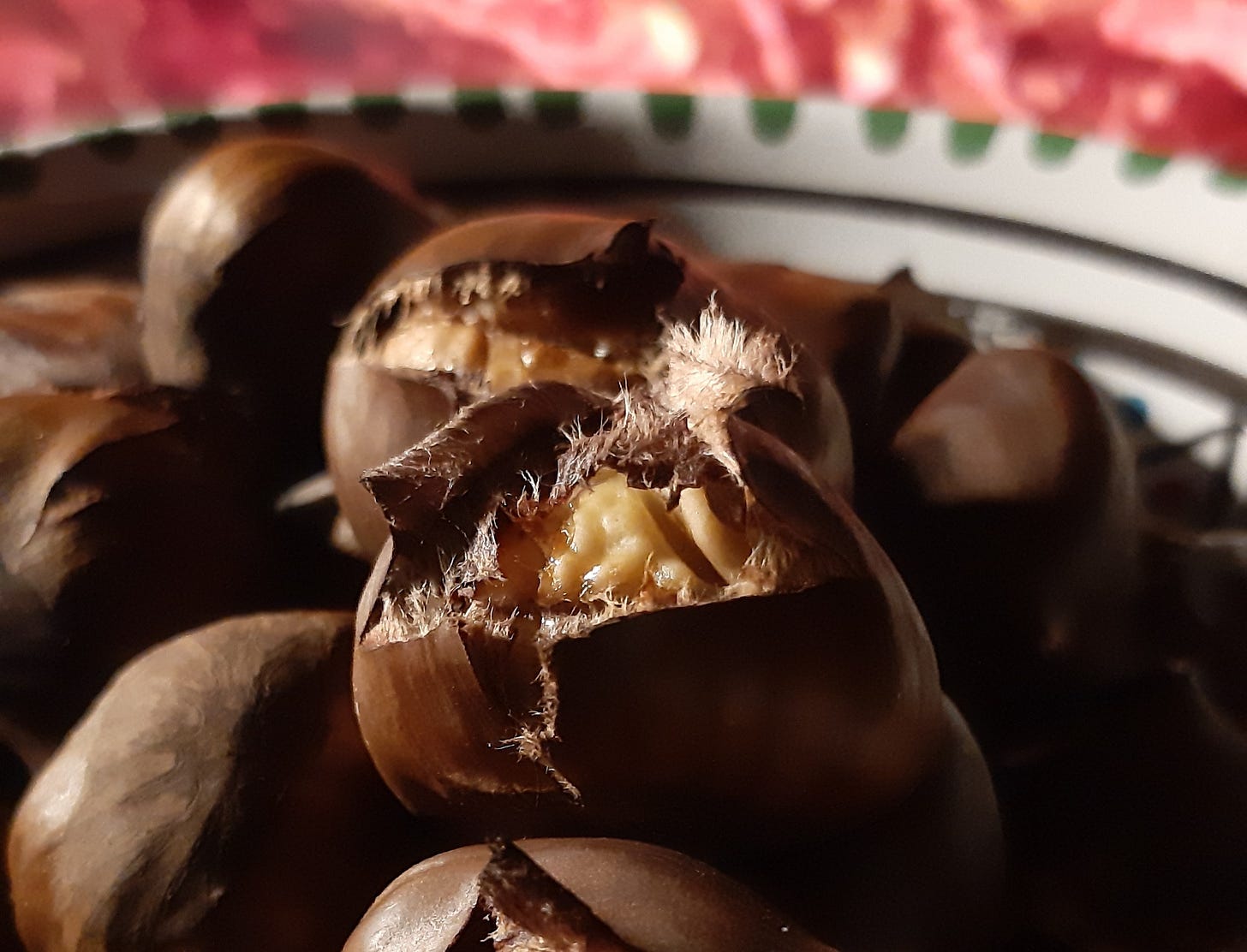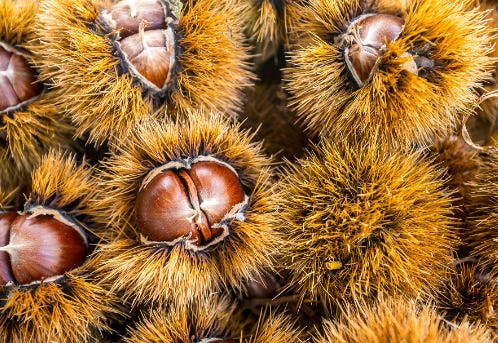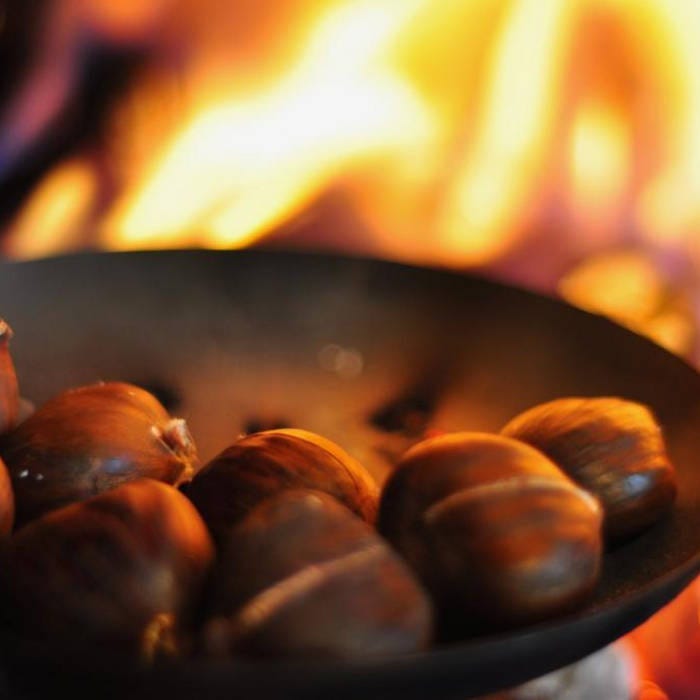The winter larder can be sparse, and many beings, human and other-than-human, must know the land intimately to find all that they need to survive the deepest dark. Roast chestnuts are a beloved and traditional Christmas food, with their lovely smoky taste, and their hot shells, once put in pockets to warm the hands of travellers, but they were also a welcome addition to the winter table of the poor.
Chestnuts contain fewer fats than many other nuts, but are rich in vitamins and minerals. They support heart health and may boost the immune system. Infusions of the leaves of the sweet chestnut tree have been used in healing respiratory diseases and whooping cough, providing even greater support for these cold, damp days. The chestnuts themselves have a high starch content, on a par with potatoes, and can be ground to make flour, which is why it’s known as the ‘bread tree’ in Italy.
There is evidence that chestnuts have been consumed by humans since at least 2,000BCE, and so, when I was small, I was taking part in a long tradition when, with my mum and my brother, I used to gather them on the walk home from school before roasting them in the oven later. I adored their interesting texture, their sweet flesh, and I found the way that their skins would become brittle after roasting fascinating. I think of them fondly, but had no idea that they had once been so important to those pushed to the hungry edges.
Sweet chestnuts are not native to the British Isles, but have been here for a very long time, having been introduced by the Romans for their fruit and their timber. Indeed, because they were a source of high energy, Roman soldiers were given chestnut porridge before going into battle. They were even used as a currency, especially in years when the harvest was poor.
Italy then has a long tradition of using chestnuts in cooking. However, having been largely replaced as an important foodstuff by the arrival of potatoes and corn from the Americas in the 16th Century, chestnuts became a subsistence food of the poor, especially those who lived in mountainous and forested areas that were unsuitable for cultivating grain. In the rainy mountains of Galicia, in the north-west of the Spanish Peninsula, there are no fewer than sixty autumn chestnut festivals between September and November. These festivals coincide with the Magosto, or the chestnut harvest, during which the rural population gather to mark the turning of the season and to gather chestnuts.
You can watch a fascinating film on a 14th Century Italian recipe for ‘chestnuts and mushrooms’ here.
However, it was largely this association with the poor which led to the decline of the chestnuts’ popularity. Bread made from chestnut flour didn’t rise in the same way that wheat-based bread did and so was looked down upon. In 1770, chestnut products were slandered as giving the eater, “a sallow complexion"1 Nevertheless, chestnut flour can be used to make breads, cakes, pies, pancakes, and pasta and is a useful thickening agent in sauces, stews, and soups; leading to the 1841 insult, “this kind of mortar which is called a soup”!
I love this video of two lovely but slightly bewildered men in deep discussion of the possible 18th Century methods of cooking of roast chestnuts.
Paradoxically, candied glazed chestnuts known as marrón glacé became a popular treat of the upper classes, especially in France. Made possible by sugar brought back from the Middle East by Crusaders, the recipe is said to have been invented by a court chef of the Duke of Savoy Carlo Emanuele I (1562-1630).2
I am endlessly fascinated by the ways in which food ebbs and flows between the rich and the poor. Oysters were once sustenance for those in poverty; indeed, Crossbones Graveyard, in one of the poorest parts of London, is absolutely littered with them. Dairy products too; milk, cream, butter, and cheese, have also been both prized and despised; something that I would like to explore more deeply when we emerge into the light with Brigid at Candlemas. And, of course, sugar. once so expensive and the preserve of the rich is now dirt cheap and used to placate those of us who have every reason to be working for a world turned upside down.
As for our Christmas traditions, as with so many things, it was during the Victorian era that the association between roast chestnuts and the season of goodwill began to strengthen.
Symbolising, nature’s abundance, good company, and a warm, full belly, it’s interesting that the chestnut’s association with Christmas came through St Martin, patron saint of beggars and outcasts, whose Feast Day on 11th November once marked the beginning of Advent, as we discussed way back on day 1 of Commoners’ Advent. Because, in the most famous story about him, he tore his cloak in two to help a man living in poverty, chestnuts were once given out on his day as a symbol of generosity. It remains traditional to share and eat chestnuts on St Martin’s Day in Portugal. But, even that was eminently practical because, unlike many other nuts, chestnuts cannot be easily stored beyond the end of the Christmas season; better then to share them in community around the roaring fire.
You may be wondering about the strange title of today’s sharing; ‘The Open Fire of the Anawim’? The anawim were the poor and outcast of Jesus’ day, and the people who he chose as his friends and companions. These were people who stayed faithful to their God in times of plenty, and in times of hardship. It is Mary, with her prayer for the hungry to be filled with good things and the rich to be sent away empty, who is called the ‘first anawim’.
Just as the Child of Winter Stars was rooted in his revolutionary mother, the anawim were rooted in the land. No doubt considered poor by those with an abundance of material possessions and power, they found plenty in the earth around them and hope in the justice that their God of Turning the Tables would bring. I kept thinking of them as I was writing this; sitting around their fires, sharing what they had, looking to the skies for the star that would change everything. An Advent people waiting in the dark.
These are the people of the mountains and forests, grinding their chestnut harvest into bread flour, the people of Galicia gathering to mark the turning of the season and to roast chestnuts together on a shared fire. They are the people of the Commons. And so are we.
I am reminded of the United Nations declaration on the rights of peasants, which states that, ‘for the purposes of the present declaration, a peasant is any person who engages, or who seeks to engage, alone or in association with others or as a community, in small scale agricultural production, for subsistence and/or for the market and who relies significantly, though not necessarily exclusively, on family or household labour and other non-monetised ways of organising labour and who has a special dependency on, and attachment to, the land.’
And so, if we do happen to be blessed by a pocketful of hot roasted chestnuts this Christmas, let’s perhaps reflect on this endless pull between the rich and the poor, between the greed to possess the land and the love of it, remember the anawim and the people of the Commons, and reaffirm in ours heart that the fire we roast chestnuts on should always be open.
And, of course, there is really only one way to end…
#CommonersAdvent #OldAdvent #CelticAdvent #StMartinsLent #WinterLent
I am determined to continue offering my work free of charge, because that too is resistance, but if you would ever like to support me with pennies you can do that at https://ko-fi.com/radicalhoneybee. Thank you so much, both for pennies and for all other forms of support, all of which are worth more than their weight in gold.
References:
Roasted Chestnuts, Wikipedia
Sweet Chestnut Tree, Wikipedia
Roasting Chestnuts: a Guide to the Cherished Italian Holiday Tradition
Chestnuts Roasting on an Open Fire: a Story of Tradition and Versatility
Roast Chestnuts Day ~ December 14th
Chestnuts: the Nutty History of a Culinary Treasure
The History of Hot Roast Chestnuts
The symbolic Reason Chestnuts Are Eaten on Christmas
Italian Grandma Makes Roasted Chestnuts
Chestnuts Roasting: Sequoias of the East
Medieval Chestnuts and Mushrooms
15 Reasons to Forage for Chestnuts This Fall, Rural Sprout
On the Anawim ~
https://www.catholicnewsagency.com/column/52385/the-anawim-who-are-they






I love chestnuts and my husband and I have sat in bed this morning having a journey to the heart of them with you! I just read Prodigal Summer by Barbara Kingsolver and learned about the demise of mist Sweet Chestnuts in America. They are tricky to process and I am fascinated by the work that went into extracting food from things like acorns for example. Food is so easy now. I have recently been processing Dandelion roots for coffee and that is a process and a half too. Worth it, but it is time consuming. Thanks again for today’s thinking! ❤️
Always such a beautiful read x